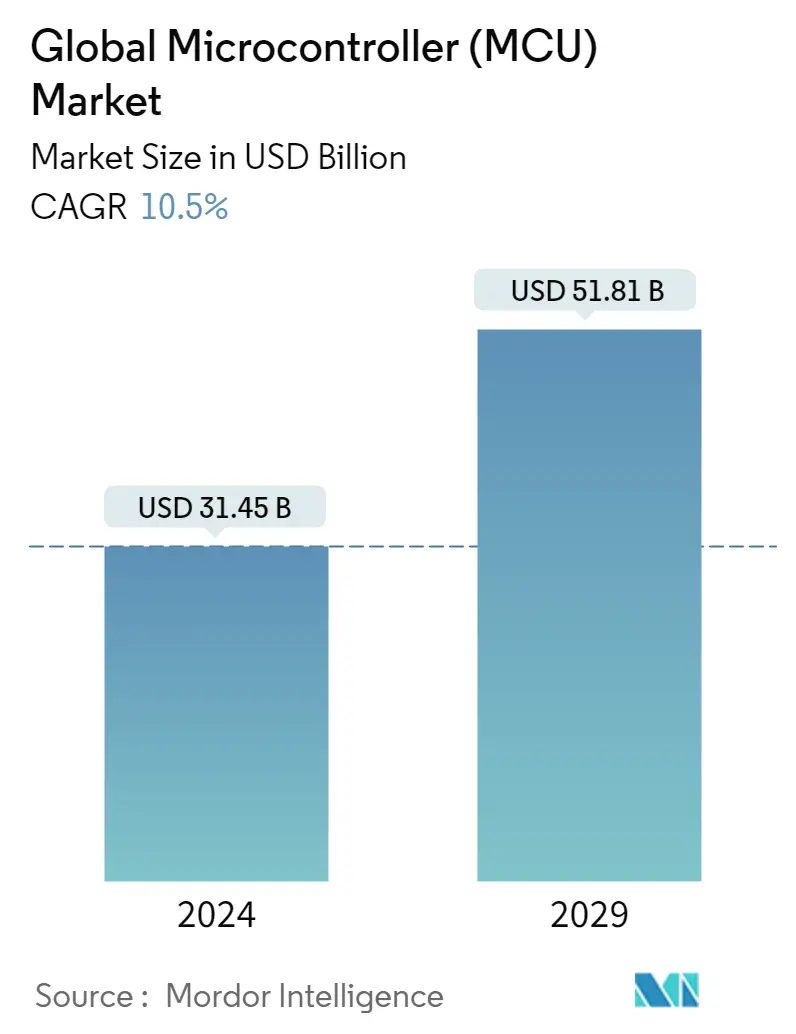Market Size of Global Microcontroller (MCU) Industry

| Study Period | 2019 - 2029 |
| Market Size (2024) | USD 31.45 Billion |
| Market Size (2029) | USD 51.81 Billion |
| CAGR (2024 - 2029) | 10.50 % |
| Fastest Growing Market | North America |
| Largest Market | Asia-Pacific |
Major Players
*Disclaimer: Major Players sorted in no particular order |
Microcontroller Unit Market Analysis
The Global Microcontroller Market size is estimated at USD 31.45 billion in 2024, and is expected to reach USD 51.81 billion by 2029, growing at a CAGR of 10.5% during the forecast period (2024-2029).
The industry scenario is constantly evolving, driven by Industry 4.0 and connected tech. Manufacturers are continually integrating new remote features to their products, and supply chain components for real-time monitoring and microcontrollers facilitate the ease of attaching compact control units to the systems.
- Microcontroller refers to compact computing units that control several peripherals and embedded systems, including home appliances, motor vehicles, robots, industrial equipment, and other devices. The unit comprises a processing unit, Input/Output (I/O) ports, on-chip storage, wireless communication modules, and several other integrative modules, which can be introduced for achieving the custom functionalities.
- The increase in the use of sensors for capturing data for monitoring various process elements is one of the fundamental driving forces for microcontrollers. The microcontroller is customized for specific usage, and the collected data is processed and shared with other aspects of the process chain. For instance, companies are looking forward to integrating RADAR, Lidar, and cameras to achieve a complete sense of the environment for autonomous vehicles and robots. These sensors are operated and interfaced with the help of microcontrollers dedicated to collecting, processing, and transferring data.
- Furthermore, the required transfer speed and the amount of data processed make room for different types of microcontrollers belonging to different architecture scales. The market majorly uses 8-bit, 16-bit, and 32-bit based microcontrollers depending upon the need of the application. Companies offer customized and ready-to-use solutions for industries, following the semiconductor manufacturing standards of wafer diameter like 200 mm.
- The COVID-19 pandemic witnessed an increment in the use of Work-from-Home electronics equipment, which shifted the focus of semiconductor manufacturing units to produce more equipment for the same. This turned the focus from other vital industries relying on microcontrollers and semiconductor chips, like automotive and industrial automation. The industry is rapidly distributing the supply chain allocation for reviving the affected industries. The process should follow through 2022 and mid-2023, witnessing promising prospects for microcontrollers globally.
Microcontroller Unit Industry Segmentation
Microcontroller Units, or MPUs, are the integrated circuits containing processing units, input and output ports, and other components on a single chip. MCUs are used extensively in today's IoT-powered and sensor-driven devices and products. The Global Microcontroller (MCU) Market is segmented by Type (8-bit, 16-bit, 32-bit), Application (Automotive, Telecommunications Infrastructure, Defense and Aerospace, Mobility, Enterprise Data Processing, Medical, consumer, Smartcard & Secure MCU, Industrial), and Geography.
| Segmentation - By Product | |
| 8-bit | |
| 16-bit | |
| 32-bit |
| Segmentation - By Application | |
| Aerospace and Defense | |
| Consumer Electronics and Home Appliances | |
| Automotive | |
| Industrial | |
| Healthcare | |
| Data Processing and Communication | |
| Other End-user Industries |
| Segmentation - By Geography | |
| North America | |
| Europe | |
| Asia-Pacific | |
| Rest of the World |
Global Microcontroller (MCU) Market Size Summary
The microcontroller market is experiencing significant growth, driven by advancements in Industry 4.0 and the increasing integration of connected technologies. Microcontrollers, which are compact computing units essential for controlling various peripherals and embedded systems, are becoming increasingly vital across diverse applications such as home appliances, automotive, robotics, and industrial equipment. The demand for microcontrollers is fueled by the rising use of sensors for data capture and monitoring, particularly in autonomous vehicles and IoT devices. These units are customizable and come in various architectures, including 8-bit, 16-bit, and 32-bit, to meet specific application needs. The COVID-19 pandemic temporarily shifted focus towards work-from-home electronics, but the industry is rapidly reallocating resources to revive sectors like automotive and industrial automation, which are crucial for the microcontroller market's expansion.
The Asia Pacific region has emerged as a pivotal hub for semiconductor manufacturing, significantly contributing to the microcontroller market's growth. The region hosts major electronics and automotive companies, with China playing a dominant role in manufacturing. The US-China trade tensions have prompted China to boost domestic microcontroller production, further driving market growth. Key players in the region, such as Taiwan Semiconductor Manufacturing Company, are instrumental in supplying microcontrollers globally. Companies like Renesas Electronics are investing heavily in expanding manufacturing capacities to meet the growing demand for high-end microcontrollers. The competitive landscape is marked by intense rivalry, with major providers continuously evolving their product offerings and engaging in strategic collaborations to capture market share. Innovations such as NXP Semiconductors' integrated time-sensitive networking microcontroller and STMicroelectronics' sub-GHz wireless connectivity solutions highlight the ongoing advancements in the industry.
Global Microcontroller (MCU) Market Size - Table of Contents
-
1. MARKET INSIGHTS
-
1.1 Market Overview
-
1.2 Industry Attractiveness - Porter's Five Forces Analysis
-
1.2.1 Bargaining Power Of Suppliers
-
1.2.2 Bargaining Power Of Buyers
-
1.2.3 Threat Of New Entrants
-
1.2.4 Threat Of Substitutes
-
1.2.5 Intensity Of Competitive Rivalry
-
-
1.3 Value Chain Analysis
-
1.4 Assessment of the Impact of Covid-19 on the Market
-
1.5 Technology Snapshot
-
-
2. MARKET SEGMENTATION
-
2.1 Segmentation - By Product
-
2.1.1 8-bit
-
2.1.2 16-bit
-
2.1.3 32-bit
-
-
2.2 Segmentation - By Application
-
2.2.1 Aerospace and Defense
-
2.2.2 Consumer Electronics and Home Appliances
-
2.2.3 Automotive
-
2.2.4 Industrial
-
2.2.5 Healthcare
-
2.2.6 Data Processing and Communication
-
2.2.7 Other End-user Industries
-
-
2.3 Segmentation - By Geography
-
2.3.1 North America
-
2.3.2 Europe
-
2.3.3 Asia-Pacific
-
2.3.4 Rest of the World
-
-
Global Microcontroller (MCU) Market Size FAQs
How big is the Global Microcontroller (MCU) Market?
The Global Microcontroller (MCU) Market size is expected to reach USD 31.45 billion in 2024 and grow at a CAGR of 10.5% to reach USD 51.81 billion by 2029.
What is the current Global Microcontroller (MCU) Market size?
In 2024, the Global Microcontroller (MCU) Market size is expected to reach USD 31.45 billion.

